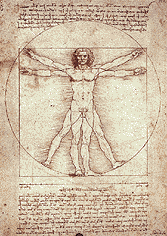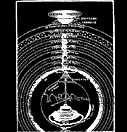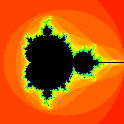This chapter focusses on the way realities are put together. Realities are based on what we believe them to be like, and thus the theories we have about how reality works more or less define that very reality until one of those theories breaks down.
Since Stephen Hawking's book "A Brief History of Time" contains a chapter containing the chain of events that led to our current view of the universe, I've mainly used this chapter as a guideline here. Anyone interested in a more thorough insight in the development of thoughts and theories on this subject probably knows enough about it already to locate the resources that suits his thirst for information best. If not, I can definitely recommend Hawking's aforementioned book.
Although Galileo is usually mentioned as the one that produced the proof that the Earth was round, Aristotle already put forward some pretty good arguments that indicated this very fact. Not only did the Earth cast a round shadow on the moon during an eclipse, from their travels the Greek also knew that the North Star appeared lower in the sky when viewed in the south than it did in more northerly regions.
I shall be completing this section at a later time, so if you wish to know more on this particular subject, you'd be best of checking back here once in a while, or checking out Hawking's "A Brief History of Time".
 "The geometry of the human body is indicative of the highest mysteries of the cosmos. The circle may be formed from a person lying on his back, with a compass placed at the navel. The square is formed from the measure of the height from head to toe, and the width of the outstretched arms. Man is a microcosm, the perfect image of the universe."
"The geometry of the human body is indicative of the highest mysteries of the cosmos. The circle may be formed from a person lying on his back, with a compass placed at the navel. The square is formed from the measure of the height from head to toe, and the width of the outstretched arms. Man is a microcosm, the perfect image of the universe."
This text was taken from a book called 'Art and symbols of the occult' (see also the credits). I hope to add some more information to enlighten you on the meaning of this, on the Golden Cut, and more on the approach during the renaissance soon. Unfortunately at the moment I've got quite a lot on my mind, so you'd be best of checking back here at a later time.
It seems that scientists are finally reaching an age where they all agree on the basic workings of the universe. As you probably know, this has not always been the case. The picture of what the universe looks like has been evolving throughout time, and up until recently, the church had quite a lot to say about what was right and what was wrong. Although it is a bit beyond the scope of what I'm trying to convey here, I've included a few interpretations of the architecture of our universe to give you some impression. An important note here is that all of these pictures and descriptions have been taken from the book Wrinkles in Time by George Smoot and Keay Davidson; an excellent book which I've just started to read and which also appears to be a great reference if you want to get a bit more actual technical backgrounds of the workings of space and matter and such.
You can click on the individual pictures to view a larger version. The images were taken from:'Wrinkles in Time', written by George Smoot & Kaey Davidson, (ISBN 0-688-12330-9); see also: credits
 Ptolemaic Picture of the Universe
Ptolemaic Picture of the Universe
Beginning twenty-five hundred years ago, the ancient Greeks organized their observations of the world into cosmological models. Once model eventually reigned supreme due to its pleasing beauty. The Egyptian astronomer Ptolemy (second century A.D.) corrected it to account for celestial observations and it was the standard cosmological model for another fourteen hundred years.
 The medieval universe
The medieval universe
Cosmology was not just the realm of science and philosophy but also included man and his pantheon. This sketch from 'The Divine Comedy' by Dante (1265-1321) shows the medieval concept of the universe, including the way the Catholic Church's theology connected with Greek (Ptolemaic) cosmology.
 Digges Infinite Universe surrounding the Copernican Solar System
Digges Infinite Universe surrounding the Copernican Solar System
The infinite universe of Thomas Digges. After the work by Copernicus (1473-1543) reforming the calendar at the pope's request, a new cosmology with the Sun at the center made the rounds. It was the Age of Exploration of the Earth (for example by the Spanish and Portuguese navigators) and of the heavens. The measured size of the Solar System increased by a factor of 10,000 in a century. The idea of a small, cozy universe gave way to a much larger system in 1576 when Thomas Digges (1543-1595) published this figure of the Copernican system, combined with an outer orb of stars expanding infinitely.
Of course, the fact that our picture of the universe changes so drastically throughout the ages does make one doubt wether the scientists who come up with these pictures are competent at all. On the other hand, the universe is just a concept, and one shouldn't place too much trust in any words that have "con-" as a prefix. The truth is that, although I've spent most of my life thinking and visualising the universe we inhibit, and reading up on this subject, I can't give you an answer here. I have my ideas about what's going on at NASA, CERN, MIT and DARPA, but most of those ideas are unconfirmed.
If chaos is king, then what does his castle look like? Any self-respecting reality-mechanic would at least venture a guess, I guess. As we do not know exactly on what rules our king's judgement is based, we could only try to approximate his laws trying to chart them derived from their impact on reality. As somewhere the strands of the lettuce that equals said reality would have to converge, to be able to make a guess at what happens at this centre of existence, one could chart the theme of convergence as it manifests itself within the boundaries of our perception. Many recurring shapes, intervals, chains of events and phenomena have been given prominent places in the everyday lives of inhabitants of our society already.
Worship of celestial objects and their movements is one possible place to start looking at how convergence manifests itself in our reality. The alignment of planets and stars alone would already be an endless source of inspiration I should think. Charting elements things have in common (either consciously or subconsciously), traversing down the lettuce to their common base as it were, is what is also known to many people as trancendental meditation.
One could also look at recurring shapes in architecture; architecture of buildings, architecture of bodies... wherever you look, you'll find the same shapes over and over again. But, to take a more precise example, let's take a look at the Great Pyramid for a moment. It's base, divided by it's height equals PI (approx. 3.1416). The meridian on which the pyramid is built divides continents and oceans exactly into two halves, and it's height times one billion (or million... I might be mistaken, for in Dutch there are slightly different words for such large numbers) equals exactly the distance between the Earth and the Sun. Also, the ground on which the pyramid is built is completely and perfectly levelled. Too perfectly. Was God a triangular man? Or maybe he is a box made up out of 6 pyramids all pointing towards the centre ;-) A nuclear Borg. Or maybe he was just another Mad Scientist... Ah, what the Hell, I'm getting a bit carried away here. Time for some relaxation, I guess.
As far as the pyramid is concerned however, according to Erich von Daniken a book named 'Our inheritance in the Great Pyramid' by Charles Piazzi Smyth from 1864 contains a wealth of astonishing correlations between the mass of the rock of the pyramid and the Earth. And correlations it is that we're talking about here. Think about the correlations between the shape of your eyes and the architecture of the observatories used to watch the skies (see also: "The Deception of Gravity")
 Although there's many synchronities and coincidances (number 23 does seem to occur a little bit too often), one of the more meaningfull examples of such a possible echo of chaos containment is the Mandelbrot-fractal. More on this will be added shortly. At the moment I would gladly point the way to a site at http://www.comlab.ox.ac.uk for more information on Mandelbrot, and on fractals in general.
Although there's many synchronities and coincidances (number 23 does seem to occur a little bit too often), one of the more meaningfull examples of such a possible echo of chaos containment is the Mandelbrot-fractal. More on this will be added shortly. At the moment I would gladly point the way to a site at http://www.comlab.ox.ac.uk for more information on Mandelbrot, and on fractals in general.
As you may, or may not know, the Universal Trinity is considered to be made up out of three elements, namely input, comput and output. Both the human brain and computers don't do very much else... there's data going in, it is processed, and as a result data may come out again. (see also: The mechanics of reality-seperation). There isn't much more worth doing anyway, for everything can be done with these three elements.
The fact that everything revolves around three simple actions is reflected in the language with which we represent the reality we experience. We have a past, a present, and a future. Something is true, false, or uncertain. The good, the bad and the ugly. In freemasonry, there's three basic ranks, and one could, in fact, go on for hours, trying to think of examples. However, the three ancient axioms, the most profound example I can think of right now, are:
- As above, so below
- Spirit rules matter
- The unseen rules the seen


